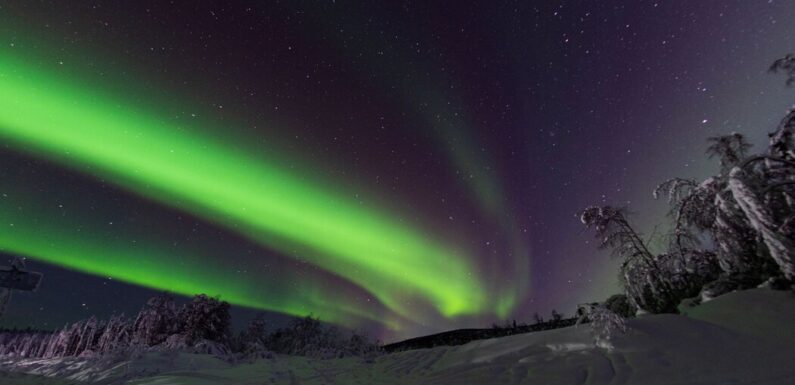
Central Pennsylvania. Southern England. Arizona.
The northern lights are most often seen in the earth’s northernmost regions, but in recent months, they’ve been visible to residents farther south. It’s not a fluke, scientists say, but part of a trend that will allow a wider swath of the world to get a rare glimpse of the phenomenon for the next few years.
The lights will be visible farther south because of a shift in the sun’s magnetic fields, which flip on an 11-year cycle. This phenomenon will peak in 2025, during the phase known as solar maximum.
The expanded visibility of the lights, created by activity in the sun’s magnetic field, has already begun, said Shannon Schmoll, the director of the Abrams Planetarium at Michigan State University.
What exactly are the lights?
The northern lights, or aurora borealis, are created when solar wind or charged particles from the sun, interact with the earth’s magnetic field, exciting atoms in the atmosphere.
Electrons jump to a higher energy level and release light — seen as the auroras — as they settle back down, she said.
Oxygen in the atmosphere creates green or red light during an aurora, while nitrogen causes blues.
Usually, the auroras are most easily viewable in places like Scandinavian countries and Northern Canada. Every winter, tourists from around the world flock to Arctic locations, venturing into the snowy night to spot the phenomenon.
The auroras have expanded farther south.
But over the past few months in the northern hemisphere, viewings of the lights have increased in areas farther south.
One cold Sunday night in February, the skies of southern England and Ireland were alight with the auroras. In March, powerful geomagnetic storms helped to make them visible as far south in the United States as North Carolina and New York. In April, they were spotted in Arizona, central California, southern Ontario and England.
In the southern hemisphere, aurora australis, or the southern lights, are typically visible from Antarctica, Australia and south of Argentina. Their visibility has also expanded.
Besides creating a beautiful show, scientists are interested in the auroras because extreme geomagnetic storms, which can create the lights, can also damage power grids, said Taylor Cameron, a research scientist with the Canadian Hazards Information Service. The last large outage of this sort was in 1989, leaving six million people in Quebec without power.
Why are the northern lights more prevalent now?
As the sun’s magnetic fields flip over 11 years, this cycle, phases between solar minimum and solar maximum, Dr. Cameron said. Experts predict that solar maximum will be reached in 2025, meaning the auroral oval, or the area on earth where the lights are visible, will widen until then.
“When we’re in the minimum part of the solar cycle, the sun is very quiet, basically nothing going on,” Dr. Cameron said. “And then at maximum, we’ve got lots of solar flares, lots of coronal mass ejections. The sun is just much more active.”
The current cycle started in 2019, he said.
The solar cycle is tied to the sun’s magnetic field, Dr. Cameron said, but doesn’t affect its temperature. In contrast to the sun’s 11-year cycle, the earth’s magnetic field reverses every tens of thousands of years.
Earth’s northern and southern hemispheres may reach solar maximum at different times, given that they can be out of sync, said C. Alex Young, an associate director for science at NASA’s heliophysics science division.
Space weather modeling, which incorporates both real data and computer models recreating space physics, allows scientists to better understand the auroras, Dr. Young said.
When and where can I expect to see them?
The best seasons to see the aurora are spring and fall, especially close to the equinoxes.
“That’s the same time in which sort of the Equator is totally flat with the rotational plane of the sun,” said William Archer, a mission scientist at the Canadian Space Agency.
Solar terrestrial events are measured by a Kp-index, which is a scale from zero to nine, Dr. Archer said. The higher the number, the more active the aurora.
A northern lights episode last month reached a Kp of eight. For central United States viewing, the Kp has to reach about seven or higher, he said. Darker areas away from city lights have the best visibility.
Trips to see the aurora often involve hunting for the perfect view, said Amy Hope, a managing director for the Aurora Zone, a northern lights tourism company based in Britain.
In the past, solar maximum has helped to grab travelers’ attention, she said. Since the aural window has expanded, Ms. Hope has received messages from friends in Scandinavia who have seen the lights from kitchen windows. Even during solar maximum, tour groups will hunt for the best view.
“What’s so addictive about it — for want of a better word — is that it’s different every single time,” Ms. Hope said.
I’m excited. Help me track them down!
The National Oceanic and Atmospheric Administration operates a short-term forecast with the location and intensity of auroras.
Experts also recommend using SpaceWeather.com and SpaceWeatherLive.com as resources to hunt for the light shows; AuroraMAX shows a livestream of the lights during winter months.
The Geophysical Institute run out of the University of Alaska Fairbanks provides forecasts for locations in North America, Europe, and the southern hemisphere.
Facebook communities have also formed for people in common aurora-spotting areas to discuss forecasts and to suggest viewing points. Many destinations have similar websites, including Fairbanks, Alaska, Canada and Iceland.
“For many people, the aurora is a beautiful nighttime phenomenon that is worth traveling to Arctic regions just to observe,” NOAA’s Space Weather Prediction Center said on its website. “It is the only way for most people to actually experience space weather.”
Source: Read Full Article
